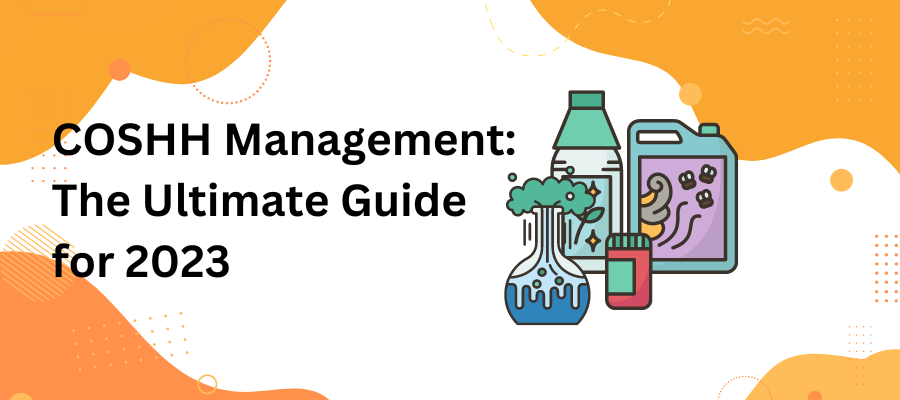Welcome to our comprehensive guide on COSHH Management! In this article, we will delve into the ins and outs of COSHH Management and its significance in the workplace. We will also explore the key elements of COSHH Management and the updated regulations for 2023. Additionally, we will provide you with valuable insights on implementing COSHH Management in your own workplace, along with inspiring case studies and lessons learned. So, let’s dive right in!
Understanding COSHH Management
Before we get started, let’s take a moment to understand what exactly COSHH Management is. COSHH, which stands for Control of Substances Hazardous to Health, is a set of regulations designed to protect employees from the potential health risks associated with hazardous substances in the workplace.
COSHH Management involves assessing potential risks, implementing control measures, and monitoring exposure to hazardous substances. By correctly managing these substances, employers can ensure the health and safety of their workforce.
What is COSHH Management?
COSHH Management is a comprehensive approach to handling hazardous substances in the workplace. It encompasses various steps to ensure the safety and well-being of employees.
The first step in COSHH Management is the assessment of potential risks. This involves identifying all the hazardous substances present in the workplace and evaluating the risks associated with their use. It is crucial to understand the properties of these substances, their potential health effects, and the likelihood of exposure.
Once the risks are identified, the next step is to implement control measures. These measures aim to eliminate or minimize the risks associated with hazardous substances. Control measures can include substitution of hazardous substances with less harmful alternatives, engineering controls such as ventilation systems, administrative controls like training and education programs, and the use of personal protective equipment (PPE).
Monitoring exposure to hazardous substances is another critical aspect of COSHH Management. Regular monitoring helps assess the effectiveness of control measures and ensures that exposure levels are within acceptable limits. Monitoring can be done through air sampling, biological monitoring, or other appropriate methods depending on the nature of the hazardous substances.
Importance of COSHH Management in the Workplace
The significance of COSHH Management cannot be overstated. It plays a vital role in protecting the health and well-being of employees and preventing workplace accidents.
Implementing effective COSHH practices is essential for companies to fulfill their legal obligations and maintain compliance with regulatory standards. Failure to comply with COSHH regulations can result in severe penalties, legal consequences, and damage to the company’s reputation.
Moreover, prioritizing COSHH Management fosters a culture of safety within the organization. When employees see that their health and safety are valued, it enhances their overall morale and job satisfaction. This, in turn, leads to increased productivity and a positive work environment.
By managing hazardous substances properly, companies can minimize the risk of accidents, injuries, and long-term health problems. COSHH Management helps identify and control potential hazards, reducing the likelihood of incidents and creating a safer workplace for everyone.
In conclusion, COSHH Management is a crucial aspect of workplace safety. It involves assessing risks, implementing control measures, and monitoring exposure to hazardous substances. By prioritizing COSHH Management, companies can protect their employees’ health, maintain compliance with regulations, and create a culture of safety and productivity.
Key Elements of COSHH Management
Now that we understand the importance of COSHH Management, let’s explore its key elements in detail.
COSHH (Control of Substances Hazardous to Health) Management is a vital aspect of workplace safety. It involves identifying, assessing, and controlling the risks associated with hazardous substances to protect the health and well-being of employees.
Risk Assessment
One of the fundamental aspects of COSHH Management is conducting thorough risk assessments. This involves identifying the hazardous substances present in the workplace, evaluating the level of risk they pose, and implementing control measures accordingly.
Risk assessments are crucial for understanding the potential harm that hazardous substances can cause. By identifying the specific substances and their associated risks, employers can develop effective strategies to minimize exposure and prevent accidents or health issues.
Control Measures
Control measures are essential for mitigating the risks associated with hazardous substances. These measures may include substitution, engineering controls, administrative controls, and personal protective equipment (PPE).
Substitution involves replacing hazardous substances with less harmful alternatives whenever possible. Engineering controls, such as ventilation systems or enclosed workspaces, aim to minimize exposure by controlling the release and spread of hazardous substances. Administrative controls, such as implementing safe work practices and procedures, help establish a culture of safety. Additionally, providing appropriate PPE, such as gloves, masks, or protective clothing, can further protect employees from direct contact with hazardous substances.
Adequate control measures can significantly reduce the likelihood of exposure and related health issues. It is essential for employers to regularly review and update these measures to ensure their effectiveness and compliance with regulations.
Health Surveillance
Health surveillance involves monitoring employees’ health to identify any potential adverse effects resulting from exposure to hazardous substances. Regular check-ups, medical examinations, and health monitoring programs are crucial for detecting early signs of health issues and taking timely action to prevent further harm.
Through health surveillance, employers can assess the effectiveness of control measures, identify any emerging health risks, and provide appropriate support and intervention to affected employees. It also helps in maintaining accurate records of employees’ health status, which can be valuable for future reference and research purposes.
Training and Supervision
An informed workforce is crucial for effective COSHH Management. Employers must provide comprehensive training and clear instructions on handling hazardous substances. Regular supervision and feedback ensure that employees understand and adhere to safe practices.
Training programs should cover topics such as hazard identification, proper handling and storage of hazardous substances, emergency procedures, and the correct use of control measures and PPE. Supervisors play a vital role in reinforcing training, monitoring compliance, and addressing any concerns or questions raised by employees.
By investing in training and supervision, employers empower their workforce to actively participate in COSHH Management, creating a safer and healthier work environment for everyone.
COSHH Management Regulations for 2023
With the ever-evolving nature of workplace health and safety, it is essential to stay updated on the latest regulations. Let’s explore the COSHH Management regulations for 2023.
The Control of Substances Hazardous to Health (COSHH) Management regulations are designed to protect workers from exposure to hazardous substances. These regulations are regularly reviewed and updated to ensure that workplace practices are in line with the latest scientific knowledge and best practices.
As we enter 2023, new regulations and guidelines may be introduced to adapt to emerging risks and improve existing practices. It is vital for employers to familiarize themselves with these updates and ensure compliance with the latest standards. Staying informed about the changes in regulations is crucial for maintaining a safe and healthy work environment.
Updated Regulations and Guidelines
The 2023 COSHH Management regulations may introduce amendments to existing requirements or introduce new guidelines to address emerging concerns. These updates are based on scientific research, industry trends, and feedback from stakeholders.
One potential area of focus in the updated regulations could be the control measures for nanomaterials. Nanotechnology is advancing rapidly, and the potential health risks associated with exposure to nanomaterials need to be carefully evaluated and addressed. The updated regulations may provide specific guidance on handling and controlling nanomaterials to minimize the risks to workers.
Another aspect that the 2023 regulations could address is the management of hazardous substances in the context of remote work or flexible work arrangements. With the rise of remote work due to the COVID-19 pandemic, employers need to ensure that their employees are protected from hazardous substances even when working outside the traditional workplace. The updated regulations may provide guidance on how to assess and manage risks associated with remote work, including the use of hazardous substances in home offices or other non-traditional work environments.
Compliance with the 2023 Regulations
Adhering to the COSHH Management regulations requires proactive measures from employers. It is not enough to simply be aware of the regulations; employers must take concrete steps to ensure compliance and protect their employees’ health.
One of the key requirements for compliance is conducting ongoing risk assessments. Employers need to regularly evaluate the substances used in their workplace, identify potential hazards, and assess the level of risk associated with each substance. This process should involve input from employees, as they are often the ones directly exposed to the hazardous substances.
Implementing control measures is another crucial aspect of compliance. Once the risks have been identified, employers must take steps to minimize or eliminate exposure to hazardous substances. This may involve implementing engineering controls, such as ventilation systems or enclosures, or providing personal protective equipment (PPE) to employees.
Monitoring employee health is also an essential part of compliance with the COSHH Management regulations. Regular health checks and medical surveillance can help detect any adverse health effects resulting from exposure to hazardous substances. This allows employers to take appropriate action to protect their employees and prevent further harm.
Compliance with the COSHH Management regulations is not only a legal obligation but also a responsibility towards employee well-being. By prioritizing the health and safety of their workforce, employers create a positive work environment and contribute to the overall productivity and success of their organization.
Implementing COSHH Management in Your Workplace
Now that we have a solid understanding of COSHH Management and the regulations, let’s delve into the steps involved in implementing it effectively in your own workplace.
Implementing COSHH Management in your workplace is crucial for ensuring the health and safety of your employees. By following the proper steps and utilizing the right tools and resources, you can create a safe working environment that minimizes the risks associated with hazardous substances.
Steps to Implement COSHH Management
1. Identify hazardous substances present: Begin by identifying and categorizing the hazardous substances present in your workplace. This involves conducting a thorough inventory of all the chemicals, solvents, gases, and other potentially harmful substances used or produced in your workplace.
It is important to consider all possible sources of hazardous substances, including cleaning agents, paints, fuels, and even biological agents like bacteria or viruses. By having a comprehensive list of these substances, you can effectively manage and control their risks.
2. Assess the risks: Once you have identified the hazardous substances, the next step is to assess the risks associated with them. This involves evaluating the potential harm these substances can cause, the likelihood of exposure, and the severity of the consequences.
Conducting a thorough risk assessment is crucial for understanding the specific hazards present in your workplace and determining the appropriate control measures. It allows you to prioritize your efforts and allocate resources effectively.
3. Implement control measures: After assessing the risks, it is important to take proactive steps to minimize them. This can be achieved through various control measures, including substitution, engineering controls, administrative controls, and providing suitable personal protective equipment (PPE).
Substitution involves replacing hazardous substances with less harmful alternatives. Engineering controls focus on modifying the workplace or processes to reduce exposure, such as installing ventilation systems or enclosing hazardous areas. Administrative controls include implementing safe work practices, establishing standard operating procedures, and providing clear instructions to employees. Lastly, providing suitable PPE, such as gloves, goggles, or respirators, can further protect employees from exposure.
4. Monitor exposure: Implementing control measures is not enough; regular monitoring of employees’ exposure to hazardous substances is essential to ensure that the control measures are effective. Monitoring can be done through air sampling, biological monitoring, or personal exposure measurements.
By monitoring exposure levels, you can identify any potential issues or areas where control measures may need to be adjusted. This allows for prompt intervention and ensures the ongoing effectiveness of your COSHH management system.
5. Provide training and supervision: Training your employees on safe handling practices and ensuring ongoing supervision is crucial for maintaining a safe working environment. All employees should receive comprehensive training on the hazards associated with the substances they work with, as well as the control measures in place.
Supervision plays a vital role in reinforcing safe practices and addressing any non-compliance or gaps in knowledge. Regular communication and feedback sessions with employees can help identify areas for improvement and ensure that everyone understands their role in maintaining a safe workplace.
In conclusion, COSHH Management plays a vital role in securing the health, safety, and well-being of employees. By understanding the key elements of COSHH Management, complying with the latest regulations, implementing effective practices, and learning from case studies, you can create a workplace environment that prioritizes employee health and fosters a culture of safety. So, embrace the principles of COSHH Management and embark on your journey towards a safer and healthier workplace in 2023!
See Evalu-8 EHS in action
The leading choice of EHS software for small to large companies in the manufacturing sector that want to get control of there safety



